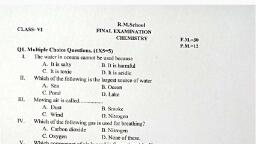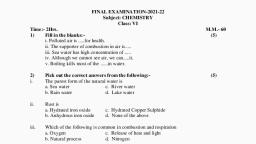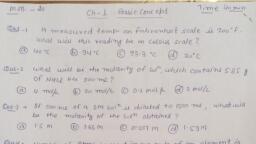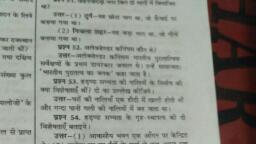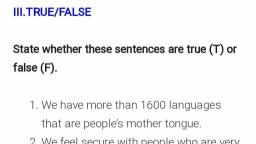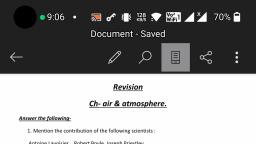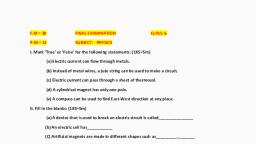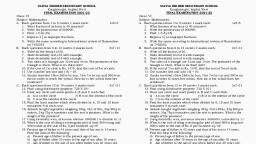Question 1 :
Number of mole of 1 <img style='object-fit:contain' src="https://storage.googleapis.com/teachmint/question_assets/NEET/5ea7fe38fdd8313cc8726aac"> gas at NTP are:
Question 2 :
Stoichiometric ratio of sodium dihydrogen orthophosphate and sodium hydrogen orthophosphate required for synthesis of <img style='object-fit:contain' src="https://storage.googleapis.com/teachmint/question_assets/NEET/5ea7fed1a3d2442ab82937d8"> is
Question 3 :
A solution of known normality is diluted to two times. Which of the following changes during dilution?
Question 4 :
Semimolar solution contains how many moles of solute in 1L of solution?
Question 5 :
Classify which of the following pair is a compound and a mixture?
Question 8 :
The weight of ${ H }_{ 2 }{ C }_{ 2 }{ O }_{ 4 }.2{ H }_{ 2 }O$ required to prepare 500 ml of 0.2 N solution is:
Question 10 :
A student performs a titration with different burettes and finds titre values of 25.2 mL, 25.25 mL, and 25.0mL. The number of significant figures in the average titre value is
Question 11 :
Which one of the following set of units represents the smallest and largest amount of energy respectively?
Question 12 :
The number of moles of solute present in 2.0 litre of 0.5 M NaOH solution is:
Question 13 :
If true enter $1$, else enter $0$.<br/>A decinormal solution is $\dfrac{1}{10}\ N$.
Question 14 :
A 1.50 g sample of an ore containing silver was dissolved,and all the $ Ag^{+} $ was converted to 0.125 g $ Ag_{2}S $. What was the percentage of silver in the ore?
Question 15 :
The ratio of mole fraction of a solute and a solvent in a binary solution is:
Question 16 :
If $0.01$ mole of solute is present in $500\ ml $ of solution, its molarity is:
Question 17 :
0.52 g of dibasic acid required 100 mL of 0.1 <img style='object-fit:contain' src="https://storage.googleapis.com/teachmint/question_assets/NEET/5ea7fccdfdd8313cc8726705"> NaOH for complete neutralization. The equivalent weight of acid is:
Question 18 :
<b></b>Calculate the volume in 10 millimoles of solute present in 0.08 M solution.
Question 20 :
The molarity of a solution is 0.2 M when 18 g of glucose is dissolved in 500 ml of water.
Question 21 :
The formula which represents the simple ratio of atoms in a compound is called:
Question 22 :
The number of moles of water in 488 g <img style='object-fit:contain' src="https://storage.googleapis.com/teachmint/question_assets/NEET/5ea7fdb5a3d2442ab829353d"> are:
Question 23 :
Approximate atomic weight of an element is 26.89 . If its equivalent weight is 8.9 , the exact atomic weight of element would be :- -
Question 24 :
How many moles of sulfate ions are in $200 mL$ of a $2 M$ sodium sulfate solution?
Question 26 :
The number of mole present in 2 litre of 0.5 <img style='object-fit:contain' src="https://storage.googleapis.com/teachmint/question_assets/NEET/5ea7fcdcfdd8313cc872674e"> NaOH is:
Question 27 :
The weight, in grams, of KCl (Mol.wt. = 74.5) in 100ml of a 0.1M KCl solution is:
Question 29 :
The least count of an instrument is 0.01 cm. Taking all precautions, the most possible error in the measurement can be
Question 33 :
1.5 litre of solution of normality N and 2.5 litres of 2M HCl are mixed together. The resultant solution has a normality of 5. The value N is:
Question 35 :
An aqueous solution contains 0.53g of anhydrous ${ { Na }_{ 2 }CO }_{ 3 }$ (Mol. wt. 106) dissolved in 100ml of solution. The molarity of the solution is:
Question 36 :
A 10% solution of $HNO_3$ would be produced by dissolving 63 g $HNO_3$ in how many mL water?<br>
Question 37 :
$(I)$. A $1\ M$ solution of sucrose $({C}_{12}{H}_{22}{O}_{11}$) can be prepared by dissolving $342.20\ g$ of sucrose to make $1000\ mL$ of sugar water solution.<br/>$(II)$. The molar mass of sucrose is $342.20\ g$ and $1\ L$ of water is the same as $100\ g$.
Question 38 :
At NTP, 1 L of $O_2$ reacts with 3 L of carbon monoxide. What will be the volume of CO and $CO_2$ after the reaction?
Question 39 :
Calculate the molarity of a solution containing 20.7 g of potassium carbonate dissolved in 500 mL of solution (assume density of solution = 1 g mL$^{-1}$).
Question 40 :
A mixture of ethanol and water contains $54\%$ water by mass. Calculate the mole fraction of ethanol in this solution.
Question 42 :
A mixture of $Na_2C_2O_4$ ($A$) and $KH_2C_2O_4.2H_2O$ ($B$) required equal volumes of $0.1$ M $KMnO_4$ and $0.1$ M $NaOH$ separately. Molar ratio of $A$ and $B$ in the mixture is :
Question 43 :
The molarity of solution and weight of sodium bromate necessary to prepare $85.5$ mL of $0.672\: N$ solution when the half-cell reaction is $BrO^{\circleddash}_3 + 6H^{\bigoplus}+ 6e^-\rightarrow Br^{\circleddash} + 3H_2O$, are respectively :
Question 44 :
To a 25 ml $ H_{2}O_{2}$ solution, excess of acidified solution of potassium iodide was added. The iodine liberated required 20 ml of $ 0.3 N \ Na_{2}S_{2}O_{3}$ solution. The volume strength of $ H_{2}O_{2}$ solution is:
Question 47 :
In an ideal mixture of liquid A and B the mole fraction of A is 0.25 . If the ratio of $ P^0_A $ to $ P^0_B $ is 7/3. how many repeated distillations would be required as a minimum to obtain a small quantity of distillate which has a mole fraction of A , better than 0.80 ?
Question 48 :
The volume of $0.05 \,M H_{2}SO_{4}$ required to neutralise $80 \,ml $ of $0.13 \,N \,NaOH$ will be
Question 49 :
Gaseous ${N}_{2}{O}_{4}$ dissociates into gaseous ${NO}_{2}$ according to the reaction ${N}_{2}{O}_{4}(g)\rightleftharpoons 2{NO}_{2}(g)$. At $300K$ and $1atm$ pressure, the degree of dissociation of ${N}_{2}{O}_{4}$ is $0.2$. If one mole of ${N}_{2}{O}_{4}$ gas is contained in a vessel, then the density of the equilibrium mixture is:
Question 50 :
100 ml of 10V $H_2O_2$ solution is heated. The evolved gas is completely reacted with Ca to form CaO. The aqueous solution of Cao is neutralised by 50 ml of $H_2SO_4$ solution. The molarity of $H_2SO4$ is:



